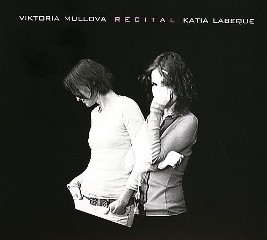Viktoria Mullova, Katia Labèque – Recital (2006)
Viktoria Mullova, Katia Labèque – Recital (2006)

Igor Stravinsky: Suite Italienne (after Pulcinella) 1.Introduction: Allegro Moderato 2.Serenata: Larghetto 3.Tarantella: Vivace 4.Gavotte con due variazioni - Allegretto - Allegretto piu tosto moderato 5.Scherzino: Presto alla breve 6.Minuetto – Finale Franz Schubert: Fantasie for violin and piano D934 7.I Andante Molto 8.II Allegretto 9.III Andantino 10.IV Tempo primo - Allegro Vivace - Allegretto – Presto Maurice Ravel: Violin Sonata (1927) 11.I Allegretto 12.II Blues: Moderato 13.III Perpetuum Mobile: Allegro 14.Clara Schumann - Romanze for violin and piano, op 22/1: No 1 in Db Major (ré bémol majeur. Ds-Dur) Viktoria Mullova – violin Katia Labèque – piano
This release by violinist Viktoria Mullova and pianist Katia Labèque (their labels, Labèque's KML and Onyx, which Mullova helped found) sees both these well-known artists stepping out from their usual roles. Mullova has been an impressive exponent of the major violin concertos who has moved into Baroque music in recent years with some success, while Labèque is known for her duo-piano work with sister Marielle (KML stands for Katia and Marielle Labèque). They fill their new roles not just adequately but spectacularly. One major attraction here is the program, a varied creation that would have been unlikely to show up on a major label but that gives Mullova a chance to speak very different sets of musical lines. The contrasts in sound here are striking, even within individual works. The opening Suite Italienne of Stravinsky is a sort of précis of Pulcinella, made in 1933 by violinist Samuel Dushkin and Stravinsky himself. Its six movements proceed from close adherence to Baroque models in this neo-Classic work to the somewhat more tense, abstract quality of the music from later in the original work. Some performers have given this suite a stately, antique feeling throughout, but Mullova and Labèque show that it can stand up to more energetic playing, and greater contrasts between sections, without losing its gravity. The Schubert Fantasie for violin and piano, D. 934, is a late and anomalous work, featuring something quite rare in Schubert's output: showpiece virtuosity in its Andantino third movement. Here the listener gets something of the Mullova familiar from her concerto recordings: sharp and commanding. The musicians change gears yet again with the Sonata for violin and piano of Ravel, really a collection of three individual pieces with its famous "Blues" slow movement flanked by an ambitious first movement and perpetual-motion finale. If there is one complaint to be made here, it is that Labèque takes a while to warm up to the structural contrasts between violin and piano that are necessary to make the first movement work. The "Blues" movement, however, is superb, with Mullova executing the jazzy slides and the work's evocation of rhythmic freedom with aplomb. Clara Schumann's Romance for violin and orchestra, Op. 22/1, makes a satisfying conclusion to the program. Among the ancillary features of this release that might be mentioned are clear sound and the contemporary design of the cover, all of which would bode well for a tour supporting the recording that went beyond the usual big-city stops. ---James Manheim, AllMusic Review
download (mp3 @320 kbs):








